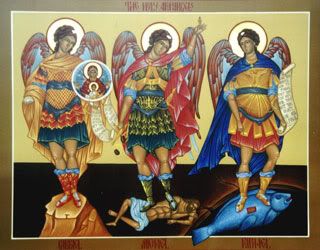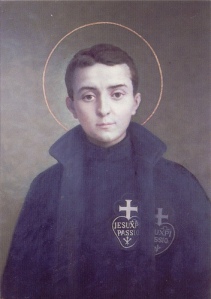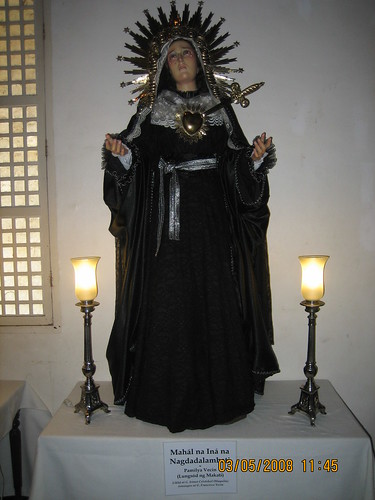Holy Michael the Archangel

Holy Michael the Archangel statue in Kiev, courtesy of The Roving Medievalist blog
(The following is excerpted from Dom Prosper Guéranger's entry in The Liturgical Year for May 8, The Apparition of Saint Michael, in Volume VIII of the 1983 Marian House edition of the English translation by the Benedictines of Stanbrook.)
"The very name of Michael urges us to honour this glorious spirit; it is a cry of enthusiasm and fidelity, for it signifies: 'Who is like unto God?' Satan trembles at hearing this name, for it reminds him of the noble protest wherewith the bright Archangel answered the call of the rebel angels. Michael proved his strength and prowess when he fought the great battle in heaven. On that account, he was made the guardian and protector of God's people; first of the Jews, and afterwards of the Christan Church, for the Synagogue has forfeited all her honours. Michael now watches over Jesus' Spouse, our mother; he supports her in her trials and she wins no triumph in which he has not had some part."
"But we are not to supposed that the holy Archangel is so engaged in attending to the general interests of Christ's kingdom on earth that he cannot listen to the prayers of each individual member of the Church. God has given him a compassionate love for men; and there is not a single soul that escapes his notice. He wields the sword in defence of the Spouse of Christ; he wars with the dragon, who is ever lying in wait for the Woman and her child [Apoc. xii 13]; but, at the same time, he is attentive to each one of us; for after having confessed our sins to Almighty God, and to the Blessed Mary ever a Virgin, we acknowledge them likewise to Blessed Michael the Archangel and beseech him to pray for us to the Lord our God [the Confiteor]."
"He assists at every death-bed, for his special office is to receive the souls of the elect on their quitting the flesh. With loving solicitude and princely bearing, he presents them to the Light Eternal and introduces them into the House of God's glory. It is Holy Church herself that tells us, in the words of her Liturgy, of these prerogatives of the great Archangel. She teaches us that he has been set over Paradise, and that God has given him the charge of leading to heaven the souls of them that are to be received there. On the last day, when our Risen Jesus is to appear on the clouds of heaven to judge mankind, all of whom will then have resumed their bodies in the general resurrection, Michael with the rest of the angels will have to fulfil a ministry of awful import -- that of separating the good from the bad. Our Catholic forefathers, in the Middle Ages, were fond of representing the holy Archangel engaged in this dread function, standing at the foot of Jesus' judgement-seat, and holding a scale, in which he is weighing the souls of men and their works...."
"Guardian angel of Holy Church! now is the time for thee to exert all the might of thine arm. Satan is furious in his efforts against the noble Spouse of thy Master; brandish thy bright sword, and give battle to this implacable enemy. The kingdom of Christ is shaken to its very foundations. Is it that the reign of the Man of Sin is about to be proclaimed on the earth? Are we near that last day when, this guilty world is to be destroyed by fire, and thou art to exercise, in the name of the Sovereign Judge, the terrible office of separating the goats from the sheep? If this earth is still to exist; if the mission of the Church is not yet completed; is it not time for thee, O Michael! to show the dragon of hell that he may not, with impunity, insult on this earth the God who created it, who redeemed it, and whose name is King of kings and Lord of lords? The forces of error and crime and unceasingly dragging the world to the brink of the precipice; save it, O glorious Archangel, by confounding the dark plots which are laid for its destruction!"

[Quoted in the above entry from Dom Guéranger]
"O Christ! the glory of the angels, the Creator and Redeemer of mankind! grant that we may ascend to the happy thrones of the heavenly citizens."
"May Michael, the angel of peace, come from heaven into this our temple, bring us sweet peace, and drive dismal war back again to hell."
"May Gabriel, the angel of strength, come and rout our ancient foe; may he often visit the heaven-loved temples which the triumphant Jesus has places throughout the world."
"May Raphael, our heavenly physician, descend and visit us, that he may heal all that are infirm and direct our faltering steps in the path of life."
"May the Virgin Queen of peace, the Mother of light; may the holy choir of angels; may the bright court of heaven ever assist and protect us."
"May the Godhead ever blessed of Father, Son, and Holy Ghost, whose glory is proclaimed through the whole world, grant us this prayer. Amen."

















